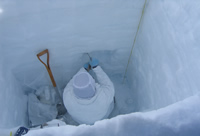Common menu bar links
Natural Elements
Pollen in the High Arctic: Nothing to Sneeze At
By Rebecca Blake
Natural Resources Canada (NRCan) palynologist Dr. Jocelyne Bourgeois is gearing up for another exciting season of field work in the High Arctic. As part of International Polar Year (IPY), and in collaboration with other international teams of scientists, Jocelyne’s group plans to examine environmental change in the High Arctic using snow and ice core samples from the northern region of Ellesmere Island. Researchers are studying the annual layers of snow and ice that have accumulated on top of a large ice cap over many years. Through this process a wide range of particulate matter, including pollen and other biological material, is trapped within the layers.
 Early summer open water over Jones Sound, north of Devon Island and south of Grise Fiord, Nunavut.
Early summer open water over Jones Sound, north of Devon Island and south of Grise Fiord, Nunavut.
“I focus on how much pollen is in the snow and ice and how much it has changed over the years,” says Jocelyne. Once the various layers are dated, the pollen identified in them can be used to reconstruct the vegetation of each period. This reconstruction allows Jocelyne to make deductions about the regional climate associated with each dated layer. “If the climate changes, it should affect the vegetation and, therefore, the change should be reflected in the pollen assemblages,” she explains.
Preparation is the first step of field work. All tools and containers must be cleaned to ensure that samples remain uncontaminated. Next, digging begins, in this case about ten metres deep. Layers are then identified, and some initial analysis is done in the field. However, the majority of Jocelyne’s frozen samples will be taken to the Polar Continental Shelf Project (PCSC) in Resolute Bay for preparation. “I drain the melted snow samples through a fine filter, which leaves behind the pollen and other biological materials,” Jocelyne explains. The small filters of biological samples are then brought back to the lab in Ottawa where they will be analyzed under a microscope.
Through collaboration, Jocelyne shares her results with international colleagues and together they look at the indicators of climate change. “Worry begins when we can’t explain the changes as natural,” she says.
 Dr. Jocelyne Bourgeois, palynologist with Natural Resources Canada, collects ice core samples on a recent trip to the Devon ice cap in Nunavut.
Dr. Jocelyne Bourgeois, palynologist with Natural Resources Canada, collects ice core samples on a recent trip to the Devon ice cap in Nunavut.
Jocelyne has been going into the field every year for 25 years now. “You get an incredible feeling inside when you’re up there,” she explains. Field work allows you to experience the environment you’re studying first hand. “Ellesmere Island is so beautiful,” exclaims Jocelyne. “I get to see places that very few people have access to.”
For a description of Jocelyne’s and other NRCan International Polar Year projects, visit the IPY section of the Government of Canada Web site. Stay tuned to Natural Elements to find out how these exciting projects unfold.

